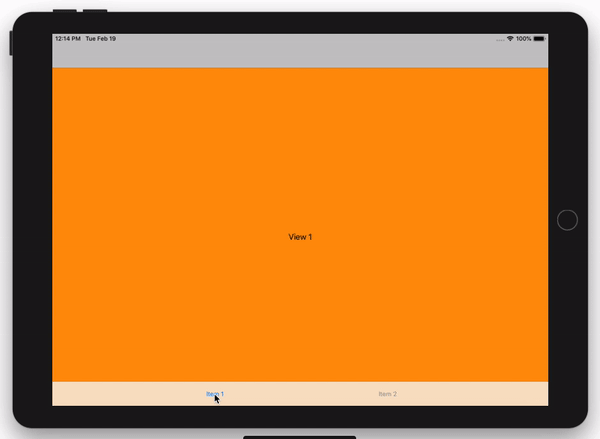How to animate Tab bar tab switch with a CrossDissolve slide transition?
There is a simpler way to doing this. Add the following code in the tabbar delegate:
Working on Swift 2, 3 and 4
class MySubclassedTabBarController: UITabBarController {
override func viewDidLoad() {
super.viewDidLoad()
delegate = self
}
}
extension MySubclassedTabBarController: UITabBarControllerDelegate {
func tabBarController(_ tabBarController: UITabBarController, shouldSelect viewController: UIViewController) -> Bool {
guard let fromView = selectedViewController?.view, let toView = viewController.view else {
return false // Make sure you want this as false
}
if fromView != toView {
UIView.transition(from: fromView, to: toView, duration: 0.3, options: [.transitionCrossDissolve], completion: nil)
}
return true
}
}
EDIT (4/23/18) Since this answer is getting popular, I updated the code to remove the force unwraps, which is a bad practice, and added the guard statement.
EDIT (7/11/18) @AlbertoGarcía is right. If you tap the tabbar icon twice you get a blank screen. So I added an extra check
If you want to use UIViewControllerAnimatedTransitioning to do something more custom than UIView.transition, take a look at this gist.

// MyTabController.swift
import UIKit
class MyTabBarController: UITabBarController {
override func viewDidLoad() {
super.viewDidLoad()
delegate = self
}
}
extension MyTabBarController: UITabBarControllerDelegate {
func tabBarController(_ tabBarController: UITabBarController, animationControllerForTransitionFrom fromVC: UIViewController, to toVC: UIViewController) -> UIViewControllerAnimatedTransitioning? {
return MyTransition(viewControllers: tabBarController.viewControllers)
}
}
class MyTransition: NSObject, UIViewControllerAnimatedTransitioning {
let viewControllers: [UIViewController]?
let transitionDuration: Double = 1
init(viewControllers: [UIViewController]?) {
self.viewControllers = viewControllers
}
func transitionDuration(using transitionContext: UIViewControllerContextTransitioning?) -> TimeInterval {
return TimeInterval(transitionDuration)
}
func animateTransition(using transitionContext: UIViewControllerContextTransitioning) {
guard
let fromVC = transitionContext.viewController(forKey: UITransitionContextViewControllerKey.from),
let fromView = fromVC.view,
let fromIndex = getIndex(forViewController: fromVC),
let toVC = transitionContext.viewController(forKey: UITransitionContextViewControllerKey.to),
let toView = toVC.view,
let toIndex = getIndex(forViewController: toVC)
else {
transitionContext.completeTransition(false)
return
}
let frame = transitionContext.initialFrame(for: fromVC)
var fromFrameEnd = frame
var toFrameStart = frame
fromFrameEnd.origin.x = toIndex > fromIndex ? frame.origin.x - frame.width : frame.origin.x + frame.width
toFrameStart.origin.x = toIndex > fromIndex ? frame.origin.x + frame.width : frame.origin.x - frame.width
toView.frame = toFrameStart
DispatchQueue.main.async {
transitionContext.containerView.addSubview(toView)
UIView.animate(withDuration: self.transitionDuration, animations: {
fromView.frame = fromFrameEnd
toView.frame = frame
}, completion: {success in
fromView.removeFromSuperview()
transitionContext.completeTransition(success)
})
}
}
func getIndex(forViewController vc: UIViewController) -> Int? {
guard let vcs = self.viewControllers else { return nil }
for (index, thisVC) in vcs.enumerated() {
if thisVC == vc { return index }
}
return nil
}
}